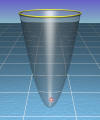Animations and Descriptions
All animations on this site are encoded using DivX r4.12 codec at 800x600 resolution, which can be downloaded here for PC, Linux or Mac. Alternately you can download the newest version from http://www.divx.com/divx/. Note: you may need to restart your web browser / video-clip player.
Fluctuations and Irreversibility: An Experimental Demonstration of a Second-Law-Like
Theorem Using a Colloidal Particle Held in an Optical Trap,
Physical Review Letters 92(14), 140601, 2002.
You can download an animation of the above experiment here (554kB). Two still shots are available below. In this animation the optical trap is represented by a parabolic glass bowl. Two types of force act on the particle: an optical trapping force that “pulls” the particle to the centre of the optical trap (ie to the bottom of the parabolic well), and a random fluctuating force caused by smaller solvent molecules (not shown) bombarding the surface of the particle, commonly known as Brownian motion.
At time t=0 the strength of the laser is increased, effectively deepening the potential well. This is shown as a deepening of the parabolic glass bowl. The zero energy point of both bowls is given by the lowest point of each individual bowl. After the strength of the optical trap is increased it is expected that the particle will move towards the bottom of the potential well, confining it to a smaller volume. However fluctuations, particularly when the trap strength has only just be increased, lead to the particle moving in an "anti second-law-like" manner. We repeat the measurements hundreds of times (in the published paper 3300) and count the number of trajectories that move towards the centre of the optical trap (bottom of the potential well) as opposed to away from it.
Experimental Demonstration of Violations of the Second Law of Thermodynamics
for Small Systems and Short Time Scales,
Physical Review Letters 89(5), 050601, 2002.
You can download an animation of the experiment described in this paper here (1421kB). Three still shots are available below. In this animation the optical trap is also represented by a parabolic glass bowl. Also present are optical trapping forces and Brownian forces (see description above).
At time t=0 the stage is translated to the left at a constant velocity. An additional force, caused by fluid flow, acts on the particle and moves it to the left-hand side of the potential. At early times the particle may move into the right-hand side of the bowl, and is considered a “violation of the second law”. It is highlighted in the animation by changing the colour of the bowls rim from gold to copper. A second version of this animation shall be created soon that uses Langevin dynamics as the source for the trajectory (ie a 'real' trajectory not a graphical illustration).
A Polymer held in an Optical Trap 'Equilibrating'
You can download this animation here (####kB). This animation shows a polymer that has been end-tethered to two latex particles. One particle is held firmly in a micro-pipette and the second is held in our optical trap. The two latex particles are held at a constant separation and the polymer's position fluctuates due to Brownian motion. The infra-red laser is illustrated by the red 'cylinder'. A second animation using the Worm-like chain model is in the process of being simulated.
Polymer Stretching using an Optical Trap
Download this animation here (1011kB). This animation shows how a polymer changes its structure as it is being stretched. The red 'cone' is used to illustrate our infra-red laser, and the micro-pipette is used to hold onto the second particle. The micro-pipette is moved away from the laser and the force acting on the particle monitored.
More animations are on their way (and a few more completed ones shall be posted as soon as the manuscripts have been accepted by the relevant journals).







